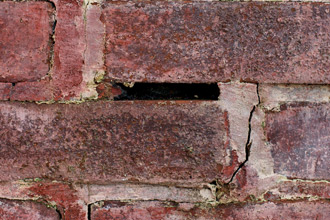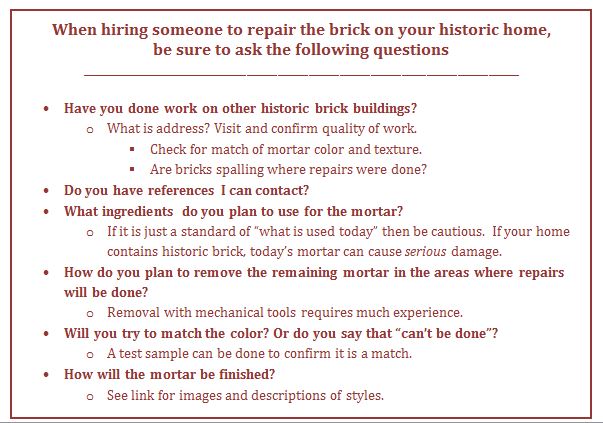Historic brick—17th–19th century
♦ Softer brick that needs to breath
♦ Necessitates softer mortar
♦ Many variations
Modern brick—mid-20th century
♦ Harder brick that does not need to breathe as much
♦ Harder mortar is more acceptable
♦ Softer brick that needs to breath
♦ Necessitates softer mortar
♦ Many variations
♦ Harder brick that does not need to breathe as much
♦ Harder mortar is more acceptable
Definition—material that distributes the load of the brick or masonry, functions as “an expansion joint and vapor membrane around masonry blocks or brick. The mortar must be weaker and more permeable than brick.”1
Replacement/repair of mortar
Do not use Portland cement on historic brick
“A basic principle of historic masonry is that mortar must always be softer than the units it touches.” 2
Color matching of mortar. An experienced mason who is familiar with historic brick will be able to create a close color match.

Fix the cause of the problem not just the symptom.
Address these problems as well or you will find yourself redoing the repairs soon.
Replacement of mortar:
Brick sealants:
Other brick coatings:
Never sandblast!

NPS Preservation Brief 1 – Assessing Cleaning and Water-Repellent Treatments for Historic Masonry Buildings by Robert C. Mack, FAIA, and Anne E. Grimmer
https://www.nps.gov/tps/how-to-preserve/briefs/1-cleaning-water-repellent.htm
NPS Preservation Brief 2—Repointing Mortar Joints in Historic Masonry Buildings by Robert C. Mack, FAIA, and John P. Speweik
http://www.nps.gov/tps/how-to-preserve/briefs/2-repoint-mortar-joints.htm
See also Brief 6—Abrasive Cleaners, 15—Concrete, 38—Graffiti, 42—Cast Stone
http://www.nps.gov/tps/how-to-preserve/briefs.htm
Preservation Brief 6—Dangers of Abrasive Cleaning to Historic Buildings by Anne E. Grimmer
http://www.nps.gov/tps/how-to-preserve/briefs/6-dangers-abrasive-cleaning.htm
NPS Preservation Brief 39—Controlling Unwanted Moisture in Historic Buildings by Sharon C. Park, AIA
http://www.nps.gov/tps/how-to-preserve/briefs/39-control-unwanted-moisture.htm
Striking and Pointing Brickwork—DIYData.com
http://www.diydata.com/techniques/brickwork/pointing/pointing.php
Eurotech—Historic Masonry Restoration Information
http://eurotechusops.com/historic-masonry-restoration/
1 Excerpt from, Repairing & Maintaining Historic Brick in the Butte Area, Alex Brown & Kelly Speer.
2 Quote from, A Handbook and Resource Guide for Owners of Virginia’s Historic Houses, Camille Agricola Bowman, Virginia Department of Historic Resources
Historic Fredericksburg Foundation, Inc.
1200 Caroline Street
Fredericksburg, VA 22401
540-371-4504
office@hffi.org
